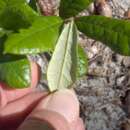Comments
provided by eFloras
Although no hybrid combinations have been formally proposed, D. M. Hunt (1989) has reported evidence of hybridization with Quercus hemisphaerica , Q . incana , Q . myrtifolia , and Q . phellos .
- license
- cc-by-nc-sa-3.0
- copyright
- Missouri Botanical Garden, 4344 Shaw Boulevard, St. Louis, MO, 63110 USA
Description
provided by eFloras
Shrubs , deciduous or tardily deciduous, to 1 m. Bark gray to dark brown. Twigs gray-brown to reddish brown, 1-2 mm diam., sparsely to uniformly pubescent. Terminal buds brown to red-brown, ovoid, 2.5-4.5 mm, glabrous or with ciliate scale margins. Leaves: petiole 1.5-4.5 mm, pubescent. Leaf blade oblong to narrowly obovate, 25-100 × 10-33 mm, base acute to rounded, margins entire, revolute, with 1 apical awn, apex acute or obtuse to rounded; surfaces abaxially uniformly gray-brown pubescent, rarely glabrate, adaxially somewhat convex, rugose, glabrous or with scattered hairs along midrib. Acorns annual; cup deeply saucer-shaped to turbinate, 5-12 mm high × 10-15 mm wide, covering 1/3-1/2(-2/3) nut, outer surface pubescent, inner surface densely pubescent, scales rarely involute, often tuberculate, tips tightly appressed, acute; nut globose to ovoid or broadly oblong, 9.5-15 × 9-12 mm, glabrate, scar diam. 5-8 mm.
- license
- cc-by-nc-sa-3.0
- copyright
- Missouri Botanical Garden, 4344 Shaw Boulevard, St. Louis, MO, 63110 USA
Distribution
provided by eFloras
Ala., Fla., Ga., Miss., N.C., S.C.
- license
- cc-by-nc-sa-3.0
- copyright
- Missouri Botanical Garden, 4344 Shaw Boulevard, St. Louis, MO, 63110 USA
Habitat
provided by eFloras
Dry sandy soils of savannahs, low ridges and oak-pine scrub, occasionally at margins of poorly drained sites; 0-100m.
- license
- cc-by-nc-sa-3.0
- copyright
- Missouri Botanical Garden, 4344 Shaw Boulevard, St. Louis, MO, 63110 USA
Quercus pumila: Brief Summary
provided by wikipedia EN
Quercus pumila, the runner oak or running oak, is a species of oak. It is native to the southeastern United States (Mississippi, Alabama, Florida, Georgia, and the Carolinas).
Quercus pumila is a deciduous shrub usually less than one meter (3 feet 3 inches) tall. The bark is gray or dark brown. The leaves are up to 10 centimetres (4 in) long, with no teeth or lobes, hairless or nearly so on the upper surface, the underside usually with a thick coat of reddish-brown hairs.
- license
- cc-by-sa-3.0
- copyright
- Wikipedia authors and editors

